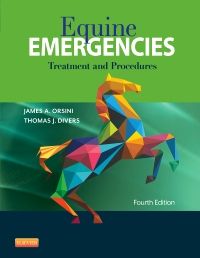Equine Emergencies, 4th Edition
Ideal for use in the clinic and in the field, Equine Emergencies: Treatment and Procedures, 4th Edition, offers practical step-by-step guidelines for effectively managing a wide range of emergency situations. Thoroughly updated content keeps you informed of the latest advances in horse care in a portable, convenient format.
Ideal for use in the clinic and in the field, Equine Emergencies: Treatment and Procedures, 4th Edition, offers practical step-by-step guidelines for effectively managing a wide range of emergency situations. Thoroughly updated content keeps you informed of the latest advances in horse care in a portable, convenient format.
New to this edition
- NEW! Chapter covering bacterial and viral diseases arms you with critical information on diagnostic labs, collection, submission, and interpretation.
- NEW! Chapter on emergency diagnostic procedures keeps you up-to-date on all the tests needed to determine the most effective treatment.
- NEW! Chapter on gene testing provides information on which gene tests and labs should be performed.
- NEW! Chapter on biopsy techniques highlights the different instruments available, endoscopic and laparoscopic techniques, as well as how to perform a pleuritis examination.
- NEW! Chapter on laboratory submission offers the latest information on tests, laboratory charts, guidelines for making an appropriate submission, and blood drawing.
- NEW! Chapters on feeding and starvation and flood injury supply the latest guidelines for nutrition, disaster medicine, and snake bites/envenomation.
Key Features
- Essential examination, diagnostic, and treatment information for each body system is presented in a logical format so you can quickly find answers during equine emergencies.
- What to Do and What Not to Do boxes guide you through the step-by-step treatment of an emergency and draw your attention to important steps to take and those to avoid.
- High-quality photographs and illustrations visually clarify key concepts and guide you through procedures step by step.
Author Information












